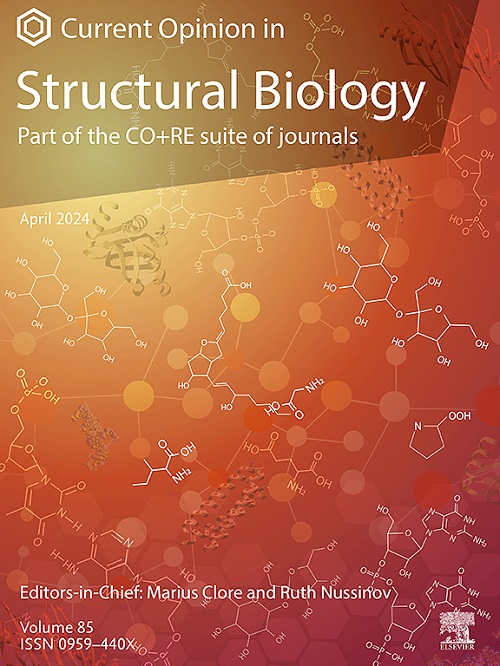Elucidating double stranded DNA viral scaffolding protein structures through advances in cryogenic electron microscopy data processing
IF 6.1
2区 生物学
Q1 BIOCHEMISTRY & MOLECULAR BIOLOGY
引用次数: 0
Abstract
Icosahedral double stranded DNA (dsDNA) virus assembly first necessitates the formation of a precursor capsid (procapsid) into which the DNA is packaged. Direct interactions between the major capsid protein (MCP) and a scaffolding protein promote proper procapsid assembly. The scaffolding protein can be an independent protein or a scaffolding-like domain covalently attached to the MCP that is comparable in structure and function. A full understanding of scaffolding protein structures has been limited by their intrinsically disordered nature. Advances in cryogenic electron microscopy (cryoEM) data processing techniques have provided new methodologies to help solve the structures of scaffolding proteins within procapsids. These structural insights further our understanding of how scaffolding proteins interact with the other assembly proteins to correctly construct the procapsid.
通过低温电子显微镜数据处理的进展来阐明双链DNA病毒支架蛋白结构
二十面体双链DNA (dsDNA)病毒组装首先需要形成一个前体衣壳(原衣壳),DNA被包装在其中。主要衣壳蛋白(MCP)和支架蛋白之间的直接相互作用促进了适当的原衣壳组装。支架蛋白可以是一个独立的蛋白,也可以是一个在结构和功能上具有可比性的与MCP共价连接的类似支架结构域。对支架蛋白结构的全面了解受到其内在无序性的限制。低温电子显微镜(cryogenic electron microscopy, cryoEM)数据处理技术的进步为解决原壳内支架蛋白的结构提供了新的方法。这些结构见解进一步加深了我们对支架蛋白如何与其他组装蛋白相互作用以正确构建原衣壳的理解。
本文章由计算机程序翻译,如有差异,请以英文原文为准。
求助全文
约1分钟内获得全文
求助全文
来源期刊

Current opinion in structural biology
生物-生化与分子生物学
CiteScore
12.20
自引率
2.90%
发文量
179
审稿时长
6-12 weeks
期刊介绍:
Current Opinion in Structural Biology (COSB) aims to stimulate scientifically grounded, interdisciplinary, multi-scale debate and exchange of ideas. It contains polished, concise and timely reviews and opinions, with particular emphasis on those articles published in the past two years. In addition to describing recent trends, the authors are encouraged to give their subjective opinion of the topics discussed.
In COSB, we help the reader by providing in a systematic manner:
1. The views of experts on current advances in their field in a clear and readable form.
2. Evaluations of the most interesting papers, annotated by experts, from the great wealth of original publications.
[...]
The subject of Structural Biology is divided into twelve themed sections, each of which is reviewed once a year. Each issue contains two sections, and the amount of space devoted to each section is related to its importance.
-Folding and Binding-
Nucleic acids and their protein complexes-
Macromolecular Machines-
Theory and Simulation-
Sequences and Topology-
New constructs and expression of proteins-
Membranes-
Engineering and Design-
Carbohydrate-protein interactions and glycosylation-
Biophysical and molecular biological methods-
Multi-protein assemblies in signalling-
Catalysis and Regulation
 求助内容:
求助内容: 应助结果提醒方式:
应助结果提醒方式:


